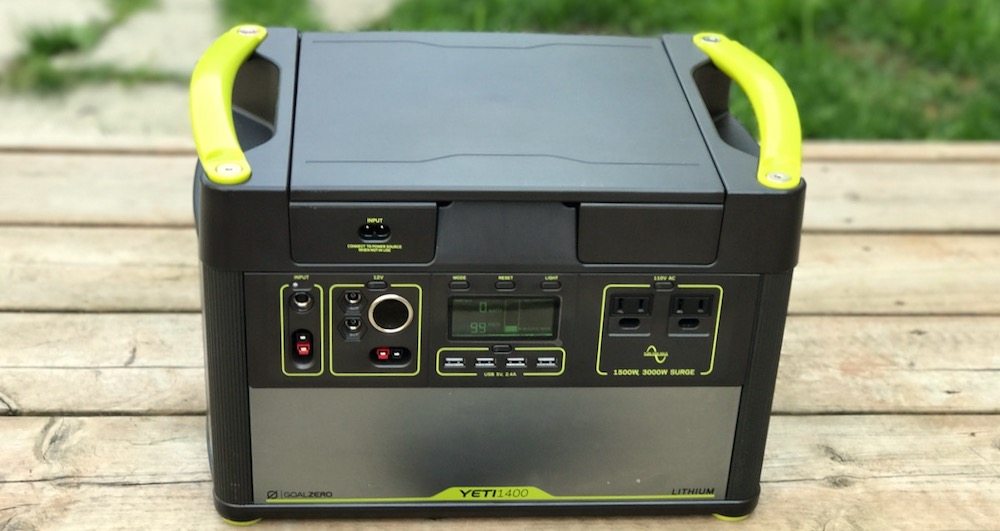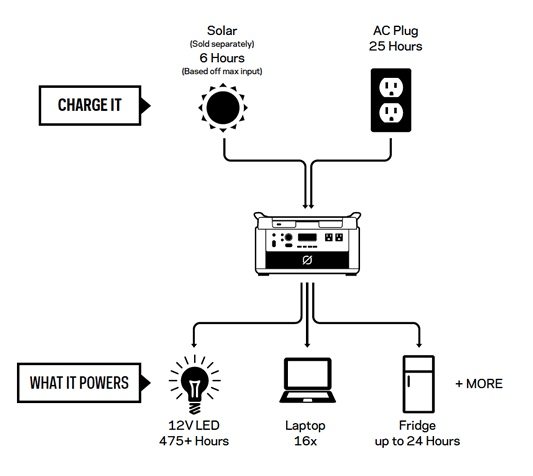Summer is here and for many people that means occasional (often unpredictable) power challenges. Thunderstorms and construction can knock out electrical power. Outdoor projects can mean needing to use power tools — far from the nearest power outlet. Goal Zero has all your emergency power needs covered off in one high capacity box: the Yeti 1400 Lithium Portable Power Station.
Goal Zero sent me a Yeti 1400 loaner to try out. The first impression is that it’s relatively compact (for what it is), but very heavy for its size. It’s basically the size of a tool box or small cooler and weighs 45 pounds. There are two carrying handles that make it easier to slug around, but no wheels.
The Yeti 400 features Goal Zero’s trademark neon green and black color scheme and the company’s usual attention to detail. A lid pops open to store the power cord, there’s an LED display on the front that shows critical info including input and output, and estimated battery time remaining based on current power draw. Naturally, there are a wealth of ports, including four 5V USB ports, a 12V port and two AC ports (pure sine wave).

If it plugs into a power source, you should be able to run it or charge it using the Yeti 1400. Goal Zero says the battery is rated for 500 cycles and can be replaced. The only odd thing about the configuration from my perspective was putting the power input port on the front instead of hiding it at the back. I’m sure there was a good reason for doing so — Goal Zero doesn’t seem to make arbitrary design choices — but it looks a little odd when recharging.
Speaking of recharging, it takes a while, but you have options. Plugged into a wall outlet and with the battery run down to zero, it took about 24 hours. With a pair of its Boulder 100 solar panels (and good weather), that can supposedly be cut down to 16 hours, while also going green. Either way, the company recommends leaving the Yeti 1400 plugged in to keep that battery topped up at all times.
As mentioned, the Yeti 1400 weighs a not inconsiderable 45 pounds. However, unlike most high capacity power banks that use less expensive (and much less energy dense) lead-acid cells, the Yeti 1400 is packed full of Lithium-Ion cells. To put the difference in some context, the UPS my iMac is plugged into weighs nearly 11 pounds and its lead-acid battery will keep the computer running for about 15 minutes. Maybe 20 minutes on a good day. The Goal Zero Yeti weighs four times more, but it packs the power to keep that computer running for 12 hours or more.
That’s right. I plugged in a 27-inch iMac (non-Retina version) and kept it running for 11 hours, with an additional four hours of use still showing on the Yeti’s display. Eight hours of that time, the iMac was being actively used for work, the remaining time it was running as a media server with the display turned off. Now I did run into a problem here… The iMac shut down without warning three times while plugged into the Yeti. The computer has a Core i7 CPU and AMD Radeon graphics card that Apple says can pull 288W, so it shouldn’t have tripped the Yeti, which is rated to handle a 1500W surge. However, something happened. I wouldn’t have noticed this with an appliance plugged in, or a smartphone being recharged — they recover immediately and without user intervention — but it was immediately obvious with the iMac, which needed to be rebooted. I checked with Goal Zero to see if they knew what might be going on here. A company engineer investigated and pinpointed the likely culprit:
“There was a problem where the software over current protection only looked for a single ‘surge’ event when triggering a fault. The random electrical noise that everything experiences added to the actual current measurement was enough to trip this protection occasionally, resulting in the port being shut down as you experienced. The newer code looks for the fault to be present for a slightly longer time before tripping to minimize the role of any noise, reducing/eliminating these false alarms.”
Fortunately, the issue is resolved with a firmware update. Unfortunately, I’d already shipped the review unit back, so I was unable to personally verify the fix.
I also plugged a refrigerator into the Yeti 1400. This was a full-sized fridge we keep in the basement to store cold drinks and overflow from the main refrigerator. It’s a decade or so old and not particularly power efficient. It ran for over 12 hours when plugged into the Yeti 1400. That’s enough run time to keep your food and drinks cold during a hot day without power.

Goal Zero says the Yeti 1400 is also suitable for use with TVs, power tools, and other uses, although it needs to be kept dry — something to think about if you were looking at it as a camping power source. And unlike gas-powered generators, the Yeti is silent (the fans will kick on during load, but they aren’t especially loud), safe to use indoors and there are no fumes or pollutants given off during operation.
The elephant in the room with the Goal Zero Yeti 1400 is cost. The MSRP is $1,999.99 which makes it a serious investment. Throw in a pair of those Boulder 100 solar panels and you’re at $2,600. When you start talking thousands of dollars, options like a Tesla PowerWall come into play.
However, the Goal Zero Yeti is still considerably less than the PowerWall 2’s $5,500 starting price, it doesn’t require installation (at additional cost), and you have the advantage of being able to pick the Yeti 1400 up and carry it to wherever it’s needed — from room to room, into the back yard or off to the cottage.
It’s definitely not cheap and it’s a little on the heavy side, but if you need a lot of backup power in a relatively compact package — and you have a sizeable budget — the Goal Zero Yeti 1400 could be what you’re looking for. The optional green charging capability is a nice bonus. If you like the concept but don’t need as much power on tap, Goal Zero offers the lower capacity Yeti 400 Lithium Portable Power Station for $699.99 and there are lead-acid battery Yeti power packs starting at $229.99.




Hi am south African and I would like to buy this product how can I get it